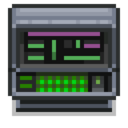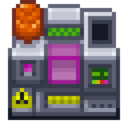Guide to Xenoarcheology: Difference between revisions
No edit summary |
No edit summary |
||
| Line 30: | Line 30: | ||
{| class="wikitable" | {| class="wikitable" | ||
|+ | |+ | ||
!Type | !Type (Image) | ||
(Image) | !Type (Name) | ||
!Type ( | |||
!Tool | !Tool | ||
|- | |- | ||
Revision as of 13:40, 8 August 2022
Do you wish to join Nanotransen's Scientists in their effort to study and collect alien artifacts? Welcome to Xenoarcheology! This guide will cover; Artifacts, Artifact Sampling, Xenoarcheology Machines, Xenoarcheology Items, Tips and tricks, Mapping.
Machines

Artifact Research Console
The artifact research console is the cornerstone of UnityStation's archeology. The artifact research console is where you will be recording all your observations about artifacts you are studying. To connect the console to an artifact, use a multitool on your desired artifact, and then use the same multitool on the console, if done correctly, the artifacts ID shall appear in the consoles UI. In order to save your data, an artifact data disk must be inserted into the console, data can then be save via the 'Write Data' Button. The accuracy of your research is important, the more accurate the data the more valuable the datadisk becomes. The datadisk with the recorded data can than be sold at cargo, a flawless datadisk will award 10,000 credits. Note: Only one disk can be sold at cargo per artifact, attempted to sell multiple disks with information about the same artifact will result in no credit gain.

Artifact Analyzer
The artifact analyzer is one of the most useful tools you have at your disposal to analyze artifacts. The analyzer can scan and deconstruct samples taken from artifacts. These scans not only provide useful data about the artifacts being study but also provide a small RP reward to its connected research server. Deconstructing samples provides materials from the samples internal composition, this can become a reliable if minor source of rare materials such as bluespace, uranium and bananium sheets.
Artifacts
Artifacts are strange objects found in the depths on space in the hearts of asteroids and the plains of lavaland. All artifacts posses effects, both positive and negative that effect their environment in a number of ways. It's your job as a scientist to study these objects and find out what their effects are.
Dormancy
All Artifacts begin in a dormant state. While in this dormant state their effects on the world are greatly reduced, dormant artifacts are relatively safe to transport and be near. When an artifact is interacted with or it suffers damage, It has a chance to wake up. This process can be stream lined by catalyzing the artifact with a Uranium Sheet. Once an artifact is awake it's full power is unleashed for better or for worse. If the science department has found itself in possession of a dangerous artifact that they wish to store, artifacts can be returned to a dormant state by exposing them to an atmosphere of Nitrous Oxide (N2O). The higher the concentration the quicker the artifact will fall dormant. Taking samples can also wake up artifacts from their dormant state.
Composition and Effects
All artifacts have an internal composition that is a combination of bluespace, uranium, bananium and a base element based on its type. An artifacts composition can be studied with the Artifact Analyzer, wether by scanning the artifact, or deconstructing it and observing the obtained materials. An artifacts composition influences it's likely hood of possessing certain effects.
Those with higher bluespace compositions are more likely to possess teleportation and summoning related effects.
Those with higher uranium compositions are more likely to possess transmutation and damaging effects.
Those with higher bananium compositions are more likely to possess physiological effects such as stuns and paranoia.
Artifact Samples
All artifacts can have samples taken from them, samples can be analyzed or deconstructed in the artifact analyzer. It is wise to note that while samples take after their parent artifacts properties, their properties can tend to vary upwards of 10%. As such Nanotransen encourages the taking of multiple samples to obtain the most accurate results. The tool needed to sample an artifact varies with its type, observe the table below for more information:
| Type (Image) | Type (Name) | Tool |
|---|---|---|

|
Geological | 
|

|
Organic | 
|

|
Mechanical | 
|
